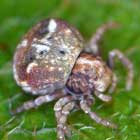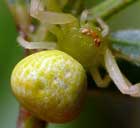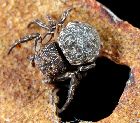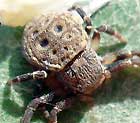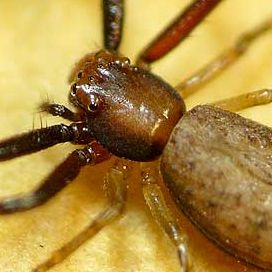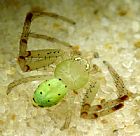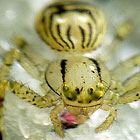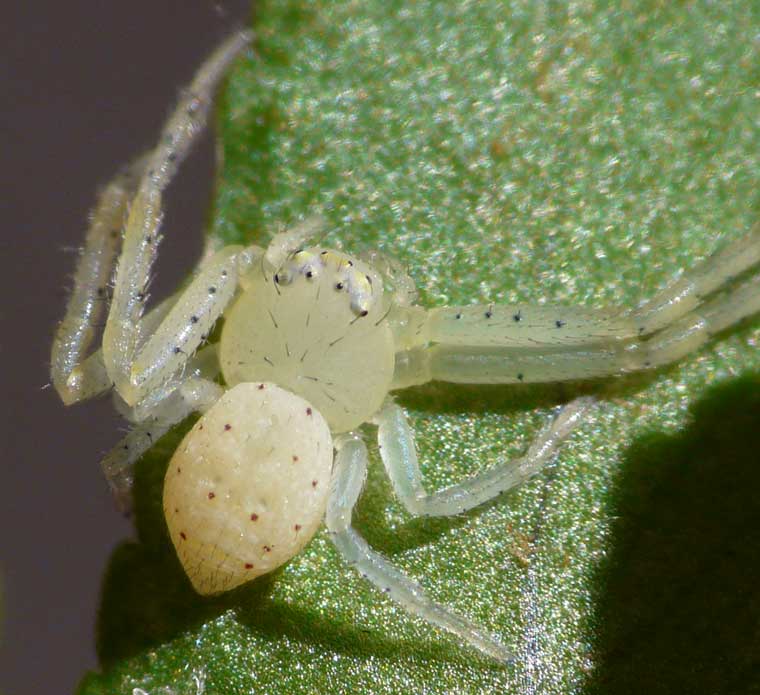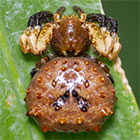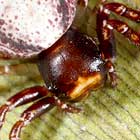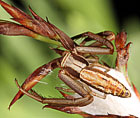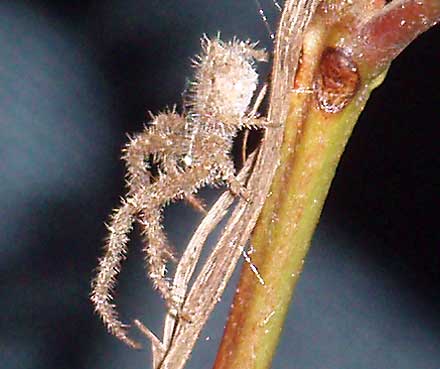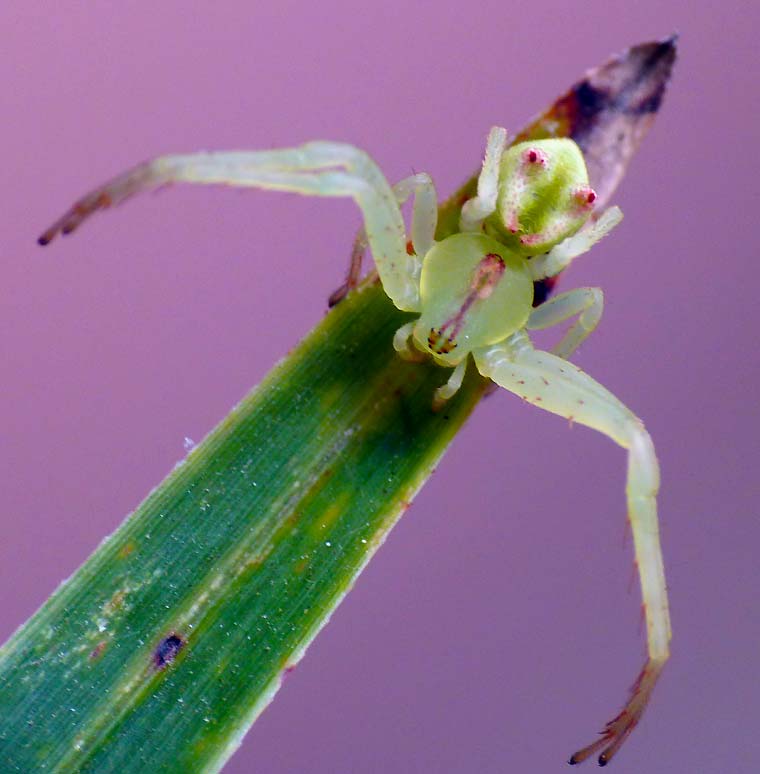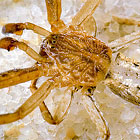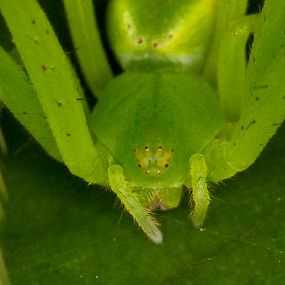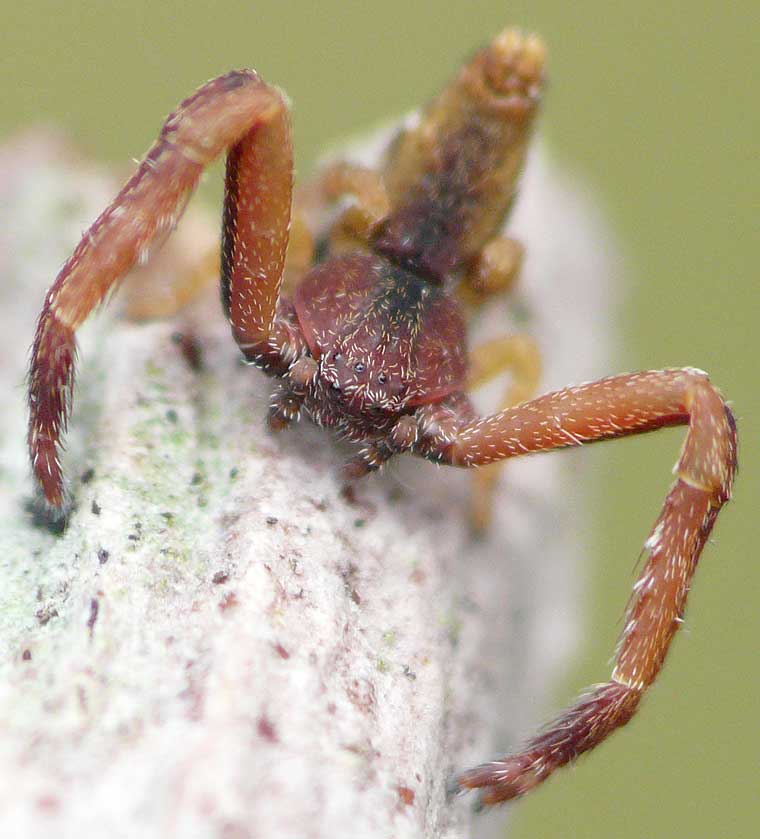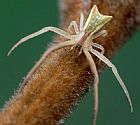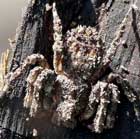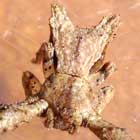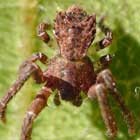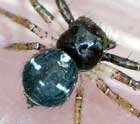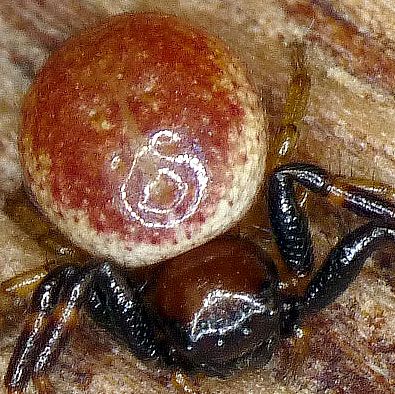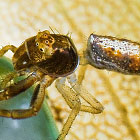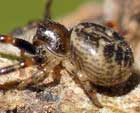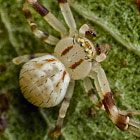Crab spiders, some also known as flower spiders, are daytime ambush hunters, common throughout Australia in most habitats, but more common in tropical and subtropical areas. Most have laterigrade legs, capable of moving sideways like a crab. They are nearly always camouflaged. Some can change colour to match flowers. Three Australian subfamilies are Stephanopinae, Thomisinae and Bominae. Stephanopinae are drab coloured, cryptic on bark. Thomisinae lack true claw tufts and have only weak cheliceral teeth. They have eight eyes arranged in two rows of four, which they can rotate independently of each other, often surrounded by white pigment and raised on small knobs or tubercles. Bominae are tiny to small spiders without strong spines on the front legs and eyes in three rows, 2 2 4. Perhaps the two most noticed Thomisids are Lehtinelagia evanida the Flower Spider and Thomisus spectabilis, the White Crab Spider.
Australomisdia cruentata (Koch 1874) Blood spattered Diaea
A small Thomisid officially recorded for NSW and Victoria but certainly more widespread. Specimens have been collected in Brisbane and on North Stradbroke Island. It is an ambush hunter, usually in flowers. This spider is wrongly identified on page 105 of Mascord's 1980 book Spiders of Australia,... 
Bomis larvata L. Koch, 1874 Miniature Crab Spider
This tiny Thomisid with a folded expandable abdomen like a bellows is recorded for coastal Queensland and NSW. Being small and hard to see, it is... 
Boomerangia dimidiata (L. Koch, 1867) Tiny Flower Spider
A small Flower Spider Spiders with roughly spherical, silver-shining abdomen with broad, dark brown stripes. Legs I and II more than
twice as long as legs III and IV. The diameter of lenses of the anterior median eyes equals the diameter of the lenses of the posterior lateral eyes. Known from... 
Cetratus rupropunctatus (Rainbow, 1920) Red-spotted Cetratus
A green crab spider with orange to red spots found Australia wide in moist habitats. The spots cluster at the rear of the cigar shaped, wrinkled abdomen. The whole spider can be plain green or even brownish. The first two pairs of legs are much more robust and longer than the others. The cephalothorax is relatively wide and slighly domed with orange on the eye region. The eyes are circled with white. Well camouflaged on green leaves where it seeks prey by ambush. ♀ 7mm ♂ 5mm 
Cymbacha cf festiva cf saucia
This specimen resembles Cymbacha saucia in most respects, the legs have transparent femurs, the upper surface of the abdomen has the saucia-like pattern, but the upper surface of the cephalothorax, or caput, does not look like Cymbachia saucia. Possibly Cymbacha festiva. 
Cymbacha ocellata
A Thomisid spider found on green leaves or in flowers but spends most of its time in a retreat made by folding the end of a leaf into a bell-shaped tent. The carapace and abdomen are somewhat roughened whereas the similar Cymbacha saucia has a smooth exterior with more obvious patterns. 
Cymbacha saucia L. Koch, 1874 Black Crab Spider
The female body length 7 mm, male 4 mm, usually found in a retreat formed from a folded leaf, distinctive markings. The upper legs have clear... 
Hedana sp
A small-medium size Thomisid not hugely common, collected mid August 2009 in a patch of good quality remant dry rainforest known as "The Island" on... 
Hedana sp
A small crab spider, the male body length 2-3mm, female 4-5mm legs I and II dark, the remainder transparent. Large cephalothorax in the male, relative to the abdomen.Typical Thomisid bulging eyes ringed with white, the carapace pale in the centre dark at the edges. Reasonably obvious large spiny hairs on the tibia. 
Isala cambridgei Large Bark Crab Spider
A widespread bark-dweller found from Queensland to Tasmania, females to 11mm, males smaller and more slender to 8mm. At rest the front legs are stretched out in front of the spider. The colour is variable depending on the bark it is living on and under, from grey to rich brown. The egg sac is made in the folded tip of a leaf. The leaf is secured by silk to a branch. (Mascord 1970). The species... 
Lehtinelagia multopunctata (L. Koch, 1874) Many-spotted Flower Spider
Lehtinelagia variabilis, Lehtinelagia evanida and Lehtinelagia multopunctata are impossible to tell apart in the field and even... 
Lehtinelagia prasina (L. Koch, 1876) Leek-green Flower Spider
This spider is quite similar to other Lehtinelagia spp. though with a fatter, rounder abdomen with distinctive markings. Named by L. Koch,... 
Lehtinelagia sp. nov. "Stripy C" plus "Pseudocetratus"
Dr Pawel Szymkowiak has provisionally called this species sp. nov. C based on specimens at the Australian collected from Mareeba North Queensland. It is a tiny Thomisid, body length about 3mm. It has since been found in many places up and down the Queensland and NSW coasts and hinterland. 
Lehtinelagia variabilis, multopunctata or evanida
Lehtinelagia variabilis, Lehtinelagia evanida and Lehtinelagia multopunctata are impossible to tell apart in the field and even... 
Monaeses brevicaudatus Koch, 1874
A distinctive genus characterized by a long narrow body, where the abdomen in most species extends beyond the spinnerets in a tail like extension. 
Phrynarachne spp. Bird Dropping Crab Spiders
These bird-dropping mimics are cryptic crab spiders usually found in northern Australia in rainforests and margins, south to the outskirts of... 
Poecilothomisus speciosus (Thorell, 1881) Beautiful Crab Spider
A common but rarely seen species in parts of North Queensland, usually found in trees lining creek banks. It is a very pretty species, sometimes... 
Porropis flavifrons Koch, 1876 Yellow-browed Porropis
A crab spider with a yellow stripe across its forehead, hence the species name. It is the type species for the genus Porropis, erected by Koch... 
Runcinia acuminata (Thorell, 1881) Pointy Runcinia
Known for a long time as Runcinia elongata, this spider is common from India to Australia and Japan. Female body length to about 10mm, males... 
Sidymella hirsuta (Koch, 1873) Hairy Crab Spider
A medium-sized, slender crab spider covered in strongly bristly hairs, reported from eastern coastal Australia and Tasmania probably more widespread in most habitats with fairly dense vegetation, including suburban parks and gardens. Most of the longer bristles are along the extremely long front... 
Sidymella longipes (L. Koch, 1874) Longlegged Sidymella
A medium to large crab spider similar to Sidymella trapezia but with longer legs. Widely distributed on Australia's east coast, probably throughout Australasia, common on New Zealand's north... 
Sidymella rubrosignata
A crab spider only found in Australia most often on Dianellas. They wait for insects or other small invertebrates to ambush. Usually green, making... 
Sidymella sp Unknown Sidymella
This Sidymella is rather like S. trapezia and S. longipes, with a rather strongly patterned cephalothorax. 
Sidymella sp. cf rubrosignata
This spider, very aggressive and quite large (aboult 1cm body length) was immature and probably not Sidymella rubrosignata which is somewhat... 
Sidymella sp. Fork-tailed and Awl-tailed Sidymella
This Sidymella, widespread and common in NSW and South East Queensland and perhaps elsewhere from rainforest to arid places, has a long, raised, sometimes festooned, sometimes double-pointed end to its abdomen. The cephalothorax is relatively flat. Legs I and II are exceptionally long and... 
Sidymella trapezia (L. Koch, 1874) Trapezoid Crab Spider
A pale, semi-transparent spider usually found on foliage, with a trapezium shaped abdomen. Darker markings follow the line of the body within the margins. Widespread and common across Australia from west to east including islands. Females to 7mm, males to 4mm. Smaller than Sidymella longipes and with more equally sized legs. Originally placed in Stephanopis by Koch in 1874, then into... 
Stephanopis altifrons (was scabra)
A common but well camouflaged Stephanopis especially against darker barks. This darker form was identified as a separate species but has since... 
Stephanopis altifrons O.P. Cambridge Knobbly Crab Spider
Knobbly Crab Spider is a slow moving, relatively timid spider that relies on its camouflage against bark to avoid predators and to hide when waiting for prey. Females up to 10mm body length, males smaller but similar. Hawkeswood notes that the mature spiders mostly feed on other spiders. 
Stephanopis barpipes Keyserling, 1890 Bearded-legs Stephanopis
A small crab spider in low foliage sometimes in great numbers. Adult females body length up to 7mm. The males are smaller but have longer legs I and... 
Stephanopis corticalis?
A small Stephanopis, of which there must be many species, hard to tell apart. Body length 4mm. Possibly S. corticalis. To determine Stephanopis... 
Stephanopis lobata (was Sidymella) Lobed Crab Spider
A small, usually dark-coloured, cryptic species, well camouflaged against bark, twigs and leaf litter, found in well-vegetated habitats in eastern Australia. Very common, probably a group of species rather than just one. Originally described by Koch from a female only in 1874, then another female... 
Stephanopis pustulosa (informal)
This spider is a cryptic species, usually found on the bark of trees, its surface colours matching those of the bark. Females 7-12mm, males 4-6 mm. The head is narrowed to a snout with eyes in this genus is almost Poltys-like. To determine Stephanopis species it seems you should look... 
Stephanopis sp? A Crab Spider
A medium sized crab, mostly grey spider with a fat, rather smooth abdomen, and a strongly two-pointed face. Females to about 9mm, males to about 4mm. 
Stephanopis sp? A Stephanopis?
A distinctive looking large Stephanopis female body length about 10mm. Carapace rectangular, eye region slightly projecting, chelicerae apparently porrect (extending forward rather than down). The carapace has a rather flat rear edge and not much in the way of bumps and knobbles. It has a... 
Synalus angustus (Koch, 1876) Narrow Crab Spider
An elongated crab spider with a somewhat roughened surface and extremely long first and second pairs of legs, found in open eucalypt woodland in NSW,... 
Tharpyna campestrata L. Koch, 1874 Rural Crab Spider
This crab spider is common throughout Australia especially in drier areas. The body length of female to 9mm, male to 7mm. Females and their egg sacs... 
Tharpyna diademata L. Koch, 1874 (diamonded Tharpyna)
A small, bark-dwelling crab spider, the female to about 4mm, the male smaller, to 3mm. The body is very dark, essentially black, flattish, with a... 
Tharpyna sp North Stradbroke Wildflower Tharpyna
A small to medium Tharpyna with some similarities to Diaea cruentata. Females to 6mm, males to 4mm. Found on wildflowers on Stradbroke Island near Blue Lake. 
Tharrhalea (Lehtinelagia) evanida (L. Koch, 1867) Northern Flower Spider
Tharrhalea (Lehtinelagia) variabilis, Tharrhalea (Lehtinelagia) evanida and Tharrhalea (Lehtinelagia) multopunctata are impossible to tell apart in the field and even with a microscope, armed with the recent revision by Pawel Szymkowiak, hard to separate. The epigyne is small... 
Tharrhalea (Lehtinelagia) or a new genus
This is a new species, possibly Tharrhalea (Lehtinelagia) or a new genus. It seems to range from south-east QLD to at least Sydney in NSW. It... 
Thomisus sp. A Crab Spider
A Thomisid resembling Thomisus spectabilis but grey and distinctive as a separate spider. 
Thomisus spectabilis Doleschall, 1859 Spectacular Crab Spider
A short, squat spider, from 3-11mm, common Australia wide, active in the day time. Some can be very white (if living in white flowers). Some can be quite yellow. They sometimes have yellow-reddish ends to the translucent legs, and black markings at the rear of the trapezoidal abdomen. The first... 
Tmarus cineraceus (L. Koch, 1876) Grey Tmarus
A small to medium-sized crab spider, camouflagued on grey bark where it hunts during the day, recorded from North Queensland to Victoria in coastal areas. Males have relatively longer legs than the female and a noticeably more slender abdomen. Mascord observed this species builds a retreat brood... 
Tmarus marmoreus (L. Koch, 1876) Marbled Crab Spider
This Thomisid spider is a live-leaf-curling species, found on shrubs or trees where it hunts by ambush, usually on light coloured bark. Rather shy and well camouflaged with a somewhat crusty appearance, it is difficult to see when still. It is widespread throughout most of Australia in rainforest... 
Tmarus variabilis (L. Koch, 1876) Variable Crab Spider
Like other Tmarus spp. this small crab spider is a live-leaf-curling species, found on foliage by day and night where it hunts stealthily, pouncing on prey and grasping it between its front legs. It may be widespread throughout most of Australian coastal areas, but can will be hard to... 
Xysticus bimaculatus L. Koch, 1867 Sub-social Crab Spider
A sub-social crab spider in medium to good-quality bushland and rainforest edges in coastal Queensland and NSW. Patterns and colours of both males and females ranging from jet black to quite pale. Many females and young live in a large, many-chambered nest in a subsocial lifestyle recently... 
Zygometis xanthogaster (L. Koch, 1876) Milky Flower Spider
A widespread, variable, small to medium-sized crab or flower spider in coastal woodland to semi-arid areas of Australia, Lord Howe Island and parts... 


